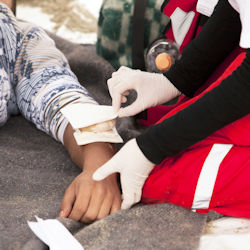Fluids That Do Not Spread Bloodborne Pathogens
Some body fluids have no documented risk of transmitting pathogens, including:
- sweat
- saliva
- urine
- feces
Although the risk of contracting a pathogen from these bodily fluids might be low, you may not always be able to tell which fluids you are handling, or whether injury has mixed them with blood.
For example, a severe abdominal injury could cause blood to be present in urine or feces. Therefore, it is best to protect yourself from ALL bodily fluids.
Occupational bloodborne pathogens are most commonly transmitted through:
- puncture wounds from a sharp or contaminated object, such as broken glass; or
- from a splash of blood to the mucous membranes of the eyes, nose, or mouth.
Protect Yourself From All Bodily Fluids
It's important to remember the Hepatitis B virus can remain infectious outside of the body for up to 7 days.

For this reason, it is essential that cleanup and decontamination of contaminated objects and surfaces be performed as soon as possible. This will reduce the risk of indirect contact resulting in a bloodborne exposure incident.
Understanding how bloodborne pathogens are transmitted will help reduce your risk of exposure and infection.
- Casual social contact, such as shaking hands, hugging, or sharing a telephone or tool, does not transmit bloodborne pathogens.
- Direct contact with blood or other potentially infectious bodily materials (OPIM) can cause an exposure incident. Indirect contact with a contaminated object, such as a countertop, bedding, or clothing, can also cause an exposure incident.
Knowledge Check Choose the best answer for the question.
1-6. Which activity can result in a bloodborne pathogens exposure incident?
You forgot to answer the question!
